初中英语-教师资格证考试-面试-阅读词汇课详案
教资初中英语词汇教案设计模板
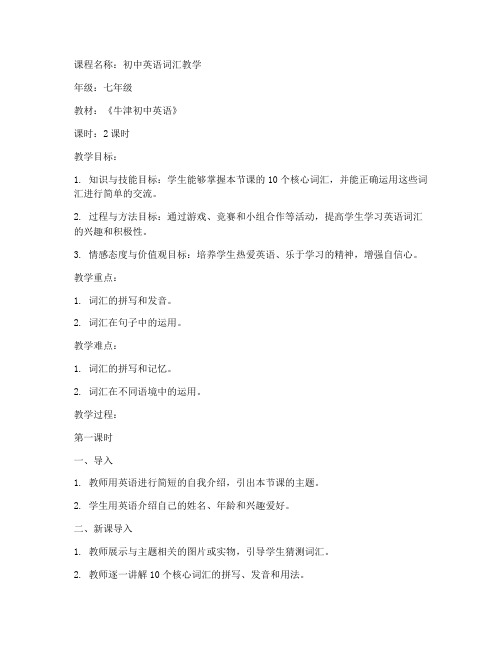
课程名称:初中英语词汇教学年级:七年级教材:《牛津初中英语》课时:2课时教学目标:1. 知识与技能目标:学生能够掌握本节课的10个核心词汇,并能正确运用这些词汇进行简单的交流。
2. 过程与方法目标:通过游戏、竞赛和小组合作等活动,提高学生学习英语词汇的兴趣和积极性。
3. 情感态度与价值观目标:培养学生热爱英语、乐于学习的精神,增强自信心。
教学重点:1. 词汇的拼写和发音。
2. 词汇在句子中的运用。
教学难点:1. 词汇的拼写和记忆。
2. 词汇在不同语境中的运用。
教学过程:第一课时一、导入1. 教师用英语进行简短的自我介绍,引出本节课的主题。
2. 学生用英语介绍自己的姓名、年龄和兴趣爱好。
二、新课导入1. 教师展示与主题相关的图片或实物,引导学生猜测词汇。
2. 教师逐一讲解10个核心词汇的拼写、发音和用法。
三、词汇学习1. 学生跟读教师示范,模仿正确的发音。
2. 学生尝试拼写词汇,教师纠正错误。
3. 学生分组进行词汇接龙游戏,巩固所学词汇。
四、词汇运用1. 教师给出句子,学生根据所学词汇进行填空。
2. 学生分组进行角色扮演,运用所学词汇进行对话。
五、课堂小结1. 教师总结本节课所学词汇,强调重点和难点。
2. 学生回顾所学内容,提出疑问。
第二课时一、复习导入1. 教师提问上节课所学词汇,检查学生对词汇的掌握情况。
2. 学生复述上节课所学内容,巩固记忆。
二、新课学习1. 教师展示与主题相关的图片或实物,引导学生猜测新词汇。
2. 教师逐一讲解新词汇的拼写、发音和用法。
三、词汇练习1. 学生跟读教师示范,模仿正确的发音。
2. 学生尝试拼写新词汇,教师纠正错误。
3. 学生分组进行词汇接龙游戏,巩固所学词汇。
四、词汇运用1. 教师给出句子,学生根据所学词汇进行填空。
2. 学生分组进行角色扮演,运用所学词汇进行对话。
五、课堂小结1. 教师总结本节课所学词汇,强调重点和难点。
2. 学生回顾所学内容,提出疑问。
教学评价:1. 学生对词汇的掌握程度。
全国教师资格证面试试讲教案词汇课(中学英语)
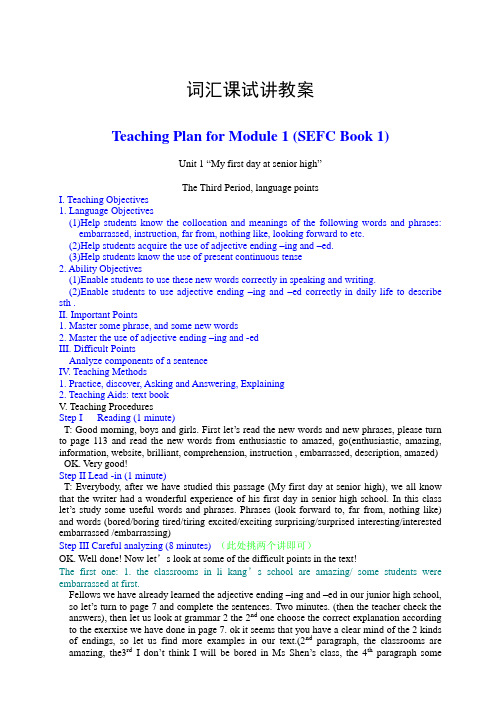
词汇课试讲教案Teaching Plan for Module 1 (SEFC Book 1)Unit 1 “My first day at senior high”The Third Period, language pointsI. Teaching Objectives1. Language Objectives(1)Help students know the collocation and meanings of the following words and phrases:embarrassed, instruction, far from, nothing like, looking forward to etc.(2)Help students acquire the use of adjective ending –ing and –ed.(3)Help students know the use of present continuous tense2. Ability Objectives(1)Enable students to use these new words correctly in speaking and writing.(2)Enable students to use adjective ending –ing and –ed correctly in daily life to describe sth .II. Important Points1. Master some phrase, and some new words2. Master the use of adjective ending –ing and -edIII. Difficult PointsAnalyze components of a sentenceIV. Teaching Methods1. Practice, discover, Asking and Answering, Explaining2. Teaching Aids: text bookV. Teaching ProceduresStep I Reading (1 minute)T: Good morning, boys and girls. First let’s read the new words and new phrases, please turn to page 113 and read the new words from enthusiastic to amazed, go(enthusiastic, amazing, information, website, brilliant, comprehension, instruction , embarrassed, description, amazed) OK. Very good!Step II Lead -in (1 minute)T: Everybody, after we have studied this passage (My first day at senior high), we all know that the writer had a wonderful experience of his first day in senior high school. In this class let’s study some useful words and phrases. Phrases (look forward to, far from, nothing like) and words (bored/boring tired/tiring excited/exciting surprising/surprised interesting/interested embarrassed /embarrassing)Step III Careful analyzing (8 minutes) (此处挑两个讲即可)OK. Well done! Now let’s look at some of the difficult points in the text!The first one: 1. the classrooms in li kang’s school are amazing/ some students were embarrassed at first.Fellows we have already learned the adjective ending –ing and –ed in our junior high school, so let’s turn to page 7 and complete the sentences. Two minutes. (then the teacher check the answers), then let us look at grammar 2 the 2nd one choose the correct explanation according to the exerxise we have done in page 7. ok it seems that you have a clear mind of the 2 kinds of endings, so let us find more examples in our text.(2nd paragraph, the classrooms are amazing, the3rd I don’t think I will be bored in Ms Shen’s class, the 4th paragraph somestudents were embarrassed at first)The next one. 2…and Ms Shen’s method of teaching is nothing like that of the teachers at my Junior High school.(the sentence under the picture)Nothing like means ,“丝毫不像”in chinese。
最新文档初中英语教资面试-词汇课教案+讲课+板书模板
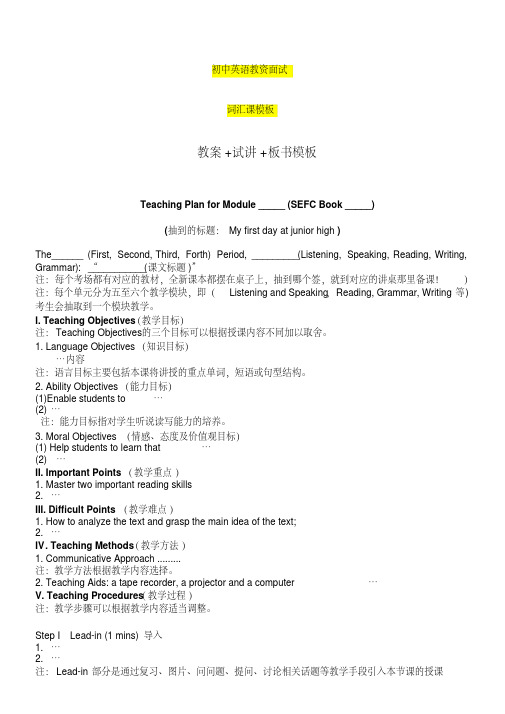
初中英语教资面试词汇课模板教案+试讲+板书模板Teaching Plan for Module _____ (SEFC Book _____)(抽到的标题:My first day at junior high)The______ (First, Second, Third, Forth) Period, _________(Listening, Speaking, Reading, Writing, Grammar): “___________(课文标题)”注:每个考场都有对应的教材,全新课本都摆在桌子上,抽到哪个签,就到对应的讲桌那里备课!)注:每个单元分为五至六个教学模块,即(Listening and Speaking,Reading, Grammar, Writing 等)考生会抽取到一个模块教学。
I. Teaching Objectives(教学目标)注:Teaching Objectives的三个目标可以根据授课内容不同加以取舍。
1. Language Objectives (知识目标)…内容注:语言目标主要包括本课将讲授的重点单词,短语或句型结构。
2. Ability Objectives(能力目标)(1)Enable students to …(2)…注:能力目标指对学生听说读写能力的培养。
3. Moral Objectives (情感、态度及价值观目标)(1) Help students to learn that…(2) …II. Important Points(教学重点)1. Master two important reading skills2. …III. Difficult Points(教学难点)1. How to analyze the text and grasp the main idea of the text;2. …IV. Teaching Methods(教学方法)1. Communicative Approach .........注:教学方法根据教学内容选择。
初中教资词汇课教案设计
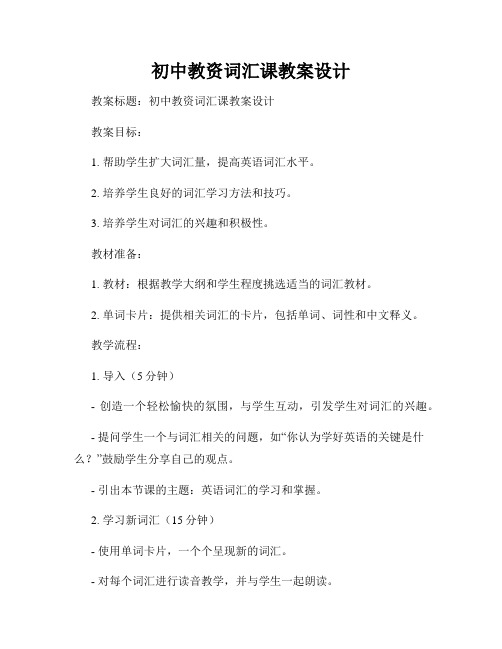
初中教资词汇课教案设计教案标题:初中教资词汇课教案设计教案目标:1. 帮助学生扩大词汇量,提高英语词汇水平。
2. 培养学生良好的词汇学习方法和技巧。
3. 培养学生对词汇的兴趣和积极性。
教材准备:1. 教材:根据教学大纲和学生程度挑选适当的词汇教材。
2. 单词卡片:提供相关词汇的卡片,包括单词、词性和中文释义。
教学流程:1. 导入(5分钟)- 创造一个轻松愉快的氛围,与学生互动,引发学生对词汇的兴趣。
- 提问学生一个与词汇相关的问题,如“你认为学好英语的关键是什么?”鼓励学生分享自己的观点。
- 引出本节课的主题:英语词汇的学习和掌握。
2. 学习新词汇(15分钟)- 使用单词卡片,一个个呈现新的词汇。
- 对每个词汇进行读音教学,并与学生一起朗读。
- 解释词汇的意思,并引导学生用英语解释词汇含义,并与中文释义进行对比。
- 与学生一起讨论词汇的词性和词义的不同用法,帮助学生更好地理解词汇。
3. 词汇活动(20分钟)- 设计一系列的词汇活动,如填空练习、造句、词义辨析等,根据学生的实际情况选择不同的活动。
- 学生可以以小组形式或个人形式参与活动,鼓励他们积极参与,相互帮助。
- 教师可以提供一些提示和指导,确保学生在活动中能够正确地运用新的词汇。
4. 课堂练习(10分钟)- 分发练习题,让学生独立完成。
- 教师可以适时地给予学生一些建议和指导。
- 检查答案,让学生相互核对,并解释正确答案。
5. 总结和反思(5分钟)- 教师引导学生回顾本节课所学的新词汇和相关知识。
- 鼓励学生分享他们的学习心得和体会。
- 提醒学生将所学的词汇应用到实际生活中,不断巩固和扩展词汇量。
教学方法和技巧:1. 创造积极的学习氛围,鼓励学生参与教学活动。
2. 引导学生主动探索和思考,促进其自主学习。
3. 多样化的词汇活动,激发学生兴趣,提高学习的效果。
教案评估:1. 教师可以观察学生在课堂活动中的参与度和表现。
2. 教师可以收集学生在课后练习中的作业,对学生的掌握程度进行评估。
教资考试初中英语教案模板
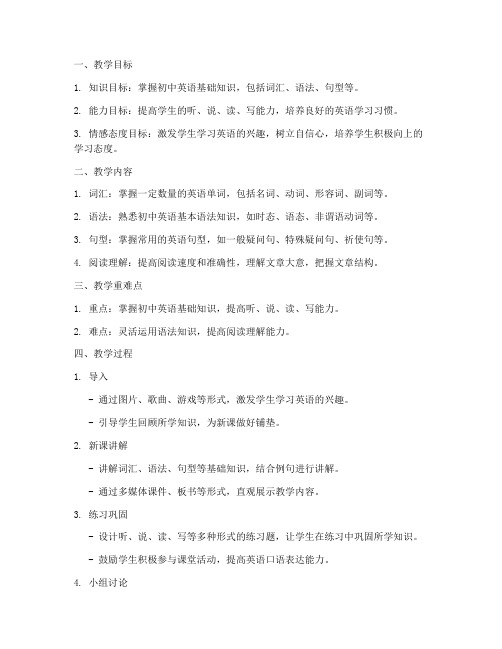
一、教学目标1. 知识目标:掌握初中英语基础知识,包括词汇、语法、句型等。
2. 能力目标:提高学生的听、说、读、写能力,培养良好的英语学习习惯。
3. 情感态度目标:激发学生学习英语的兴趣,树立自信心,培养学生积极向上的学习态度。
二、教学内容1. 词汇:掌握一定数量的英语单词,包括名词、动词、形容词、副词等。
2. 语法:熟悉初中英语基本语法知识,如时态、语态、非谓语动词等。
3. 句型:掌握常用的英语句型,如一般疑问句、特殊疑问句、祈使句等。
4. 阅读理解:提高阅读速度和准确性,理解文章大意,把握文章结构。
三、教学重难点1. 重点:掌握初中英语基础知识,提高听、说、读、写能力。
2. 难点:灵活运用语法知识,提高阅读理解能力。
四、教学过程1. 导入- 通过图片、歌曲、游戏等形式,激发学生学习英语的兴趣。
- 引导学生回顾所学知识,为新课做好铺垫。
2. 新课讲解- 讲解词汇、语法、句型等基础知识,结合例句进行讲解。
- 通过多媒体课件、板书等形式,直观展示教学内容。
3. 练习巩固- 设计听、说、读、写等多种形式的练习题,让学生在练习中巩固所学知识。
- 鼓励学生积极参与课堂活动,提高英语口语表达能力。
4. 小组讨论- 将学生分成小组,讨论与教学内容相关的话题,培养学生的合作能力和团队精神。
5. 总结- 对本节课所学内容进行总结,强调重点和难点。
- 布置课后作业,巩固所学知识。
五、教学评价1. 课堂表现:观察学生在课堂上的参与程度、发言积极性等。
2. 作业完成情况:检查学生的课后作业,了解学生对知识的掌握程度。
3. 定期测试:通过单元测试、期中考试、期末考试等形式,全面评估学生的学习成果。
六、教学反思1. 不断调整教学方法,提高教学质量。
2. 关注学生的学习需求,因材施教。
3. 丰富课堂活动,激发学生学习兴趣。
4. 加强与学生的沟通,了解学生的学习状况,及时调整教学策略。
通过以上教学过程,使学生掌握初中英语基础知识,提高听、说、读、写能力,为教资考试打下坚实基础。
教资初中英语词汇教案设计模板

一、教学目标1. 知识目标:(1)学生能够正确拼读并书写本单元的20个核心词汇。
(2)学生能够理解并运用这些词汇进行简单的口头和书面表达。
2. 能力目标:(1)学生能够通过多种方式记忆和复习词汇,提高词汇运用能力。
(2)学生能够运用词汇进行简单的描述,提高语言表达能力。
3. 情感目标:(1)激发学生学习英语的兴趣,培养学生积极向上的学习态度。
(2)培养学生关注校园生活,热爱学校的情感。
二、教学重点与难点1. 教学重点:(1)正确拼读和书写本单元的核心词汇。
(2)运用词汇进行简单的口头和书面表达。
2. 教学难点:(1)词汇的记忆和复习方法。
(2)词汇在实际语境中的运用。
三、教学过程1. 导入新课(1)教师通过图片、视频或话题讨论等方式,引导学生回顾上一单元所学内容,激发学生学习兴趣。
(2)教师简要介绍本单元的主题,让学生对本单元的学习内容有所了解。
2. 词汇学习(1)教师展示本单元的核心词汇,引导学生拼读并跟读。
(2)教师通过游戏、竞赛等形式,让学生进行词汇记忆练习。
(3)教师讲解词汇的用法,引导学生进行实际语境中的运用。
3. 词汇复习(1)教师组织学生进行词汇听写,检查学生对词汇的掌握情况。
(2)教师引导学生运用所学词汇进行造句,提高词汇运用能力。
(3)教师设计情景对话,让学生在真实语境中运用词汇。
4. 课堂小结(1)教师对本节课所学内容进行总结,强调重点和难点。
(2)教师鼓励学生在课后继续复习词汇,提高英语水平。
5. 课后作业(1)复习本节课所学词汇,掌握其拼读和书写。
(2)运用所学词汇进行写作练习,提高书面表达能力。
四、教学评价1. 课堂表现:观察学生在课堂上的参与度、积极性和合作精神。
2. 词汇掌握:通过听写、造句等形式,评估学生对词汇的掌握程度。
3. 课后作业:检查学生对课后作业的完成情况,了解学生对词汇的实际运用能力。
五、教学反思1. 教师根据学生的反馈,调整教学方法,提高教学效果。
2. 教师关注学生的个体差异,因材施教,使每个学生都能在课堂上有所收获。
初中英语教资面试试讲教案模板
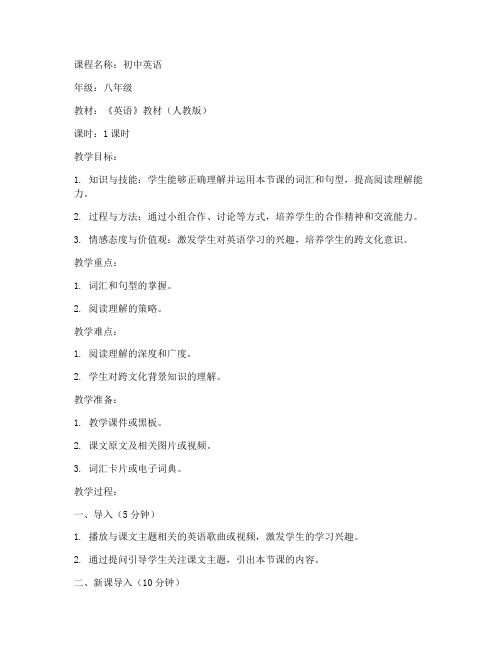
课程名称:初中英语年级:八年级教材:《英语》教材(人教版)课时:1课时教学目标:1. 知识与技能:学生能够正确理解并运用本节课的词汇和句型,提高阅读理解能力。
2. 过程与方法:通过小组合作、讨论等方式,培养学生的合作精神和交流能力。
3. 情感态度与价值观:激发学生对英语学习的兴趣,培养学生的跨文化意识。
教学重点:1. 词汇和句型的掌握。
2. 阅读理解的策略。
教学难点:1. 阅读理解的深度和广度。
2. 学生对跨文化背景知识的理解。
教学准备:1. 教学课件或黑板。
2. 课文原文及相关图片或视频。
3. 词汇卡片或电子词典。
教学过程:一、导入(5分钟)1. 播放与课文主题相关的英语歌曲或视频,激发学生的学习兴趣。
2. 通过提问引导学生关注课文主题,引出本节课的内容。
二、新课导入(10分钟)1. 引导学生阅读课文,了解文章大意。
2. 分析课文结构,找出文章的主要观点和论据。
三、词汇教学(10分钟)1. 介绍课文中的重点词汇,通过图片、实物等方式帮助学生理解。
2. 通过游戏或练习,让学生学会运用新词汇。
四、语法教学(10分钟)1. 介绍课文中的重点句型,讲解语法知识。
2. 通过例句和练习,让学生掌握句型结构,提高运用能力。
五、阅读理解(15分钟)1. 引导学生进行快速阅读,找出文章的主要信息。
2. 深入阅读,分析文章细节,回答相关问题。
3. 分组讨论,分享阅读感受,提高合作能力。
六、总结与反思(5分钟)1. 引导学生总结本节课的学习内容,巩固所学知识。
2. 学生反思自己的学习过程,提出改进意见。
七、作业布置(2分钟)1. 完成课后练习题,巩固所学知识。
2. 预习下一节课的内容,为后续学习做好准备。
教学评价:1. 观察学生在课堂上的参与度,了解学生对知识的掌握情况。
2. 课后收集学生的作业,评估学生的学习效果。
备注:1. 教师应根据学生的实际情况调整教学内容和进度。
2. 鼓励学生积极参与课堂活动,提高学习兴趣。
教案模板:教师资格证面试初中英语万能教案模板
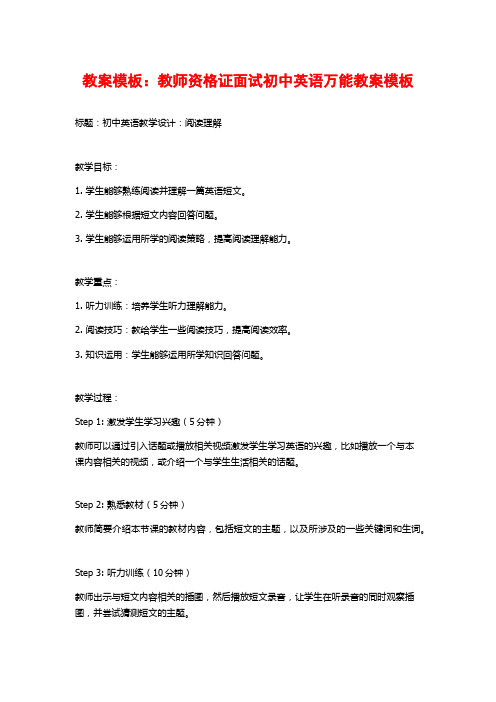
教案模板:教师资格证面试初中英语万能教案模板标题:初中英语教学设计:阅读理解教学目标:1. 学生能够熟练阅读并理解一篇英语短文。
2. 学生能够根据短文内容回答问题。
3. 学生能够运用所学的阅读策略,提高阅读理解能力。
教学重点:1. 听力训练:培养学生听力理解能力。
2. 阅读技巧:教给学生一些阅读技巧,提高阅读效率。
3. 知识运用:学生能够运用所学知识回答问题。
教学过程:Step 1: 激发学生学习兴趣(5分钟)教师可以通过引入话题或播放相关视频激发学生学习英语的兴趣,比如播放一个与本课内容相关的视频,或介绍一个与学生生活相关的话题。
Step 2: 熟悉教材(5分钟)教师简要介绍本节课的教材内容,包括短文的主题,以及所涉及的一些关键词和生词。
Step 3: 听力训练(10分钟)教师出示与短文内容相关的插图,然后播放短文录音,让学生在听录音的同时观察插图,并尝试猜测短文的主题。
Step 4: 阅读理解(15分钟)教师将短文分段呈现给学生,每段后面配有一些问题。
学生阅读每段后,回答相应的问题。
教师可以借用问题的形式,引导学生仔细阅读每一段,理解其中的细节信息。
Step 5: 提高阅读效率(10分钟)教师介绍一些常用的阅读技巧,比如利用标题和关键词快速浏览短文,利用上下文推测生词的意思等。
教师还可以给学生一些练习题,让学生在课后进行巩固。
Step 6: 小组讨论(10分钟)将学生分为小组,让他们在小组内分享自己的阅读体验和使用的阅读技巧。
教师可以指导学生讨论如何提高阅读效率,如何理解短文中的难点。
Step 7: 总结归纳(5分钟)教师总结本节课的教学内容,回顾学生所学的阅读策略和技巧,并指导学生如何在日常学习中运用这些策略和技巧。
Step 8: 作业布置(5分钟)教师布置课后阅读一篇相关的英语短文,并要求学生运用所学的阅读策略和技巧,回答问题,并写一篇读后感。
教学反思:本节课通过听力训练、阅读理解和小组讨论等多种方式,提高学生的阅读理解能力,并引导学生运用所学的阅读策略和技巧。
初中英语教资面试-阅读 词汇课详案
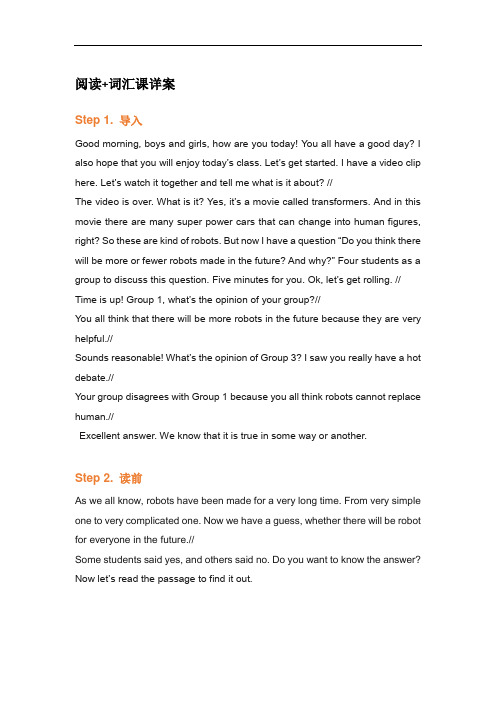
阅读+词汇课详案Step 1. 导入Good morning, boys and girls, how are you today! You all have a good day? I also hope that you will enjoy today’s class. Let’s get started. I have a video clip here. Let’s watch it together and tell me what is it about? //The video is over. What is it? Yes, it’s a movie called transformers. And in this movie there are many super power cars that can change into human figures, right? So these are kind of robots. But now I have a question “Do you think there will be more or fewer robots made in the future? And why?” Four students as a group to discuss this question. Five minutes for you. Ok, let’s get rolling. // Time is up! Group 1, what’s the opinion of your group?//You all think that there will be more robots in the future because they are very helpful.//Sounds reasonable! What’s the opinion of Group 3? I saw you really have a hot debate.//Your group disagrees with Group 1 because you all think robots cannot replace human.//Excellent answer. We know that it is true in some way or another.Step 2. 读前As we all know, robots have been made for a very long time. From very simple one to very complicated one. Now we have a guess, whether there will be robot for everyone in the future.//Some students said yes, and others said no. Do you want to know the answer? Now let’s read the passage to find it out.Step 3. 读中You are supposed to skim for 3 minutes and then tell me the main idea and the answer to our last question. //Finished? So what’s the main idea of this passage? Jack, please. Jack said that it’s mainly about robots, such as the shape of them and the function of them. Is he right? Yes, nicely done. sit down please. And next question, whether there will be robot for everyone in the future? Milly? You said that different people hold different opinions. But who is agree and who is not? No? others? You all don’t know? Ok, that’s all right.Let’s read the passage carefully again and then we do a match about who is agreed/disagreed that there will be robots just like human. L et’s do it! Here we go! //Who could answer this question? Any volunteers? Yes, Peter. //Ok, he said “scientist James White thinks that it will be difficult for a robot to do the same things as a person.” Is he right? Yes. he has got exactly the right answer. You really read very carefully about this text. I can tell. Sit down please.Another question for you. Why fewer people will do simple jobs over and over again? Iris, please. You said that because they are boring, but robots never get bored. Is she r ight? Excellent! Then in this sentence. I find two words. “bored” and “boring”. They are very much alike. What’s the difference between them? Jack? You think they are the same? Think it again. Look at the sentence. The subject of the first sentence is jobs, right? But the subject of the second sentence is human-like robots. So can you tell the difference now? You said boring is to describe things and bored is used to describe human or human like things. Yes, exactly. Now everyone clear about the difference between them? Ok, now I have a filling the blank task on the blackboard for you. 2 minute foryou to fill in them with proper words. I see all of you have finished. who would like to come to the blackboard and finish them? Ok, Rita puts up her hand. Brave girl. Come here.//She finished. Please go back to your seat. Let’s check the answer together. The first one, right, the second one, right. And the third one? Not right? Ok, let’s help her correct it. It should be “Her mother wore a worried look.” Not worrying. Because the action is done by a person, right? ok, very good. Now, do you all clear about their difference? Ok.Now, let’s read this passage out loud together and pay attention to your pronunciation.//Your voices are all so beautiful.Step 4. 读后We have already read through this passage and get the meaning of it. Now we are going to have a debate on the topic of “Will there be robots just like human?” In the debate sentence patterns learned should be used, ok? Let’s see which side would be better. //You really had a hot debate. I can see each side has made clear their opinions and explain their reasons. You all did a very good job in this debate.Step 5. 总结Now Cindy, can you summarize what we have learned in this lesson today? Quite right, we have learnt a passage about robots and know some details about it. And we learn two very much alike words and know their difference ….You know what? All of you could in the future help promote the development of robot. And learning knowledge constantly is of great importance. Always bear in mind.Step 6. 作业Today’s homework is to collect more information about robots and write a review about this article. And next class I hope that you can share your own review in front of the class. My dear class, let’s call it a day.板书:。
初中英语试讲词汇教案

初中英语试讲词汇教案1. 知识目标(1)学生能够掌握本课的六个词汇:fashionable, unfashionable, expensive, cheap, modern, old-fashioned。
(2)学生能够正确运用这些词汇描述衣物和用品。
2. 能力目标(1)学生能够在图片的帮助下正确使用目标词汇进行简单交流。
(2)学生能够通过词汇学习,提高自己的观察力和表达能力。
3. 情感目标培养学生热爱生活,关注时尚的意识。
二、教学重难点1. 教学重点:掌握并运用六个词汇描述衣物和用品。
2. 教学难点:正确运用词汇表达自己的观点和看法。
三、教学方法1. 情景教学法:通过设定情景,让学生在实际语境中学习和运用词汇。
2. 游戏教学法:通过趣味游戏,激发学生的学习兴趣,巩固词汇。
3. 任务型教学法:通过完成任务,提高学生的实际运用能力。
四、教学过程1. 热身(5分钟)教师与学生进行简单的英语对话,询问学生最近的穿着打扮,引导学生谈论时尚话题。
2. 引入(10分钟)教师展示一组衣物和用品的图片,让学生观察并猜测这些物品的名称。
然后教师揭示答案,引导学生说出这些物品的特点。
3. 新课词汇教学(15分钟)教师展示本课的六个词汇:fashionable, unfashionable, expensive, cheap, modern, old-fashioned。
通过图片和例句,让学生理解并记忆这些词汇的含义。
4. 实践活动(10分钟)学生分成小组,每组挑选一张衣物或用品的图片,用本课学到的词汇描述这张图片。
其他小组的学生需要根据描述猜测图片的内容。
5. 游戏环节(10分钟)教师组织学生进行“词汇接龙”游戏。
学生需要根据教师给出的词汇,用本课的词汇接龙。
例如,教师说“fashionable”,学生需要回答“expensive”。
6. 总结与作业(5分钟)教师对本课的内容进行总结,强调六个词汇的用法。
然后布置作业:让学生写一篇短文,描述自己最喜欢的衣物或用品,并说明原因。
全国教师资格证面试试讲教案阅读课(中学英语)

阅读课试讲教案I、Title:Unit 4 Body languageII、Teaching aims:1.Knowledge aims: Train the ability of reading.2.Ability aims: Enable the students to realize the importance of body language and understanddifferent body language in different cultures.3.Emotional aims: Stimulate the students’ interest and love for learning body language as wellas to learn verbal language.III、Teaching key points:1. Fast reading to get general idea of the text.2. Careful reading to understand the passage better.IV、Teaching difficult points:Understand the words and sentences in different context.V、Teaching Procedures:Step 1 Lead-inUse some pictures of Tai Lihua to lead in the topic.Step 2 Pre-readingPlay a guess game: ask some students to act out the meanings in chart on page25, and havethe rest students guess the meaning from the body language.Step 3 While-readingActivity 1: Prediction:Predict what the reading passage is about by two questions:1. Where are the people?2. What are they doing?Activity 2:Skimming1. Let the students skim the whole passage to get the main idea.2. Let the students skim the passage and divide it into different parts to find out the main ideaof every part and the topic sentences.Activity 3: Careful readingAsk the students to read carefully and finish the following tasks.Exercise1: What were the two mistakes that the author noticed?Exercise 2: Read the statements and decide whether it is true or false and give the reasons.Step 4 Post-readingRetell the whole text.Step 5 HomeworkSearch more information about the world ’body language , and write a short passage about 100 words.VI、Layout design:Unit 4 Body language1. Where are the people?2. What are they doing?Main ideas:Part 1 (p1) Meet business people from several countriesPart 2 (p2~4) Not all cultures greet each other the same wayPart 3 (p5) A conclusion of the passage。
1 初中英语教资面试《试讲》各大课型之词汇课教案+逐字稿
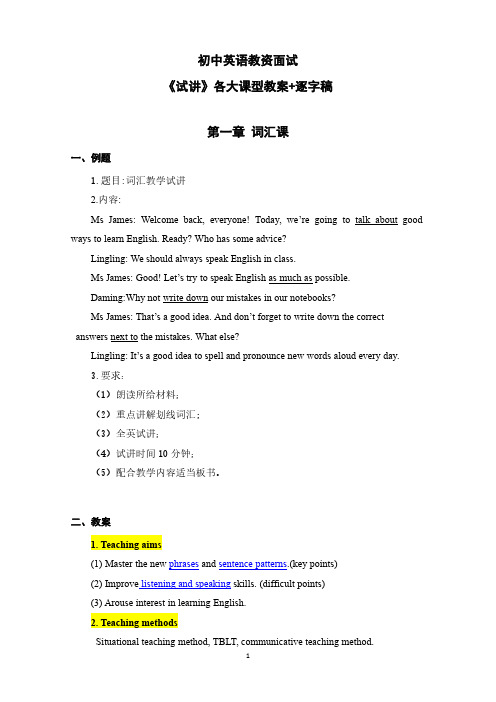
初中英语教资面试《试讲》各大课型教案+逐字稿第一章词汇课一、例题1.题目:词汇教学试讲2.内容:Ms James:Welcome back,everyone!Today,we’re going to talk about good ways to learn English.Ready?Who has some advice?Lingling:We should always speak English in class.Ms James:Good!Let’s try to speak English as much as possible.Daming:Why not write down our mistakes in our notebooks?Ms James:That’s a good idea.And don’t forget to write down the correct answers next to the mistakes.What else?Lingling:It’s a good idea to spell and pronounce new words aloud every day.3.要求:(1)朗读所给材料;(2)重点讲解划线词汇;(3)全英试讲;(4)试讲时间10分钟;(5)配合教学内容适当板书。
二、教案1.Teaching aims(1)Master the new phrases and sentence patterns.(key points)(2)Improve listening and speaking skills.(difficult points)(3)Arouse interest in learning English.2.Teaching methodsSituational teaching method,TBLT,communicative teaching method.3.Teaching proceduresStep1.Warm-up and lead-in(1)Sing:<Monsters>.(2)Video:sitcom Friends.(Rachel and Monica;chatting in different languages)→Title:ways to learn EnglishStep2.Presentation(1)Find the main idea:What’s the conversation mainly about?(how do they improve their English)(2)Show the new words:talk about≈discuss;as much as—He doesn't earn as much as I do;write down—(action);next to—where is the little girl,she is next to car (picture)(3)Show the scentences:We should……;Why not……;Step3.Practice(1)Fill in the blanks.(A.we're going to talk abou t good ways to learn English.B.Don't forget to write down the correct answers next to the mistakes.…)(2)Pass the ball.Read the phrases.Step4.ProductionDiscussion:How do you improve your English?Step5.Summary and homework(1)Summary:Different ways to improve English;Emotion.(2)Homework:other interesting ways to improve English.5.Blackboard design三、逐字稿Step1.Warm-up and lead-inT:Class begins!Boys and girls,how are you today?Oh,you all look tired.Howabout singing a song to cheer up?Are you ready?Let's go!I see your monsters,I see your pain.Tell me your problems,I'll chase them away.I'll be your lighthouse,I'll make it okay.When I see your monsters,I'll stand there so brave,and chase them all away. OK,feel better now?Great,it’s time for class.(And,)At the beginning of the class,I’d like to show you a video.It's taken from sitcom Friends.Please look at the screen.What can you see in the video?(手指屏幕)Do you know the answer?Yes,Rachel and Monica.Any others?They are chatting in different languages.Excellent!You know so much about the video.Would you like to learn something more?(回答总结)Today,we are going to learn a new lesson—Ways to learn English.(板书课题)Step2.PresentationGuys,please open your books.Now,I will show a short material for you.Listen carefully and think about the following question:What’s the conversation mainly about? 3minutes for you.Now,let's start.(停顿1~2s)(如有朗读要求,此处插入朗读文本)OK,stop here.Who can answer the question?The boy in glasses,you please.It is about how do they improve their English.(复述答案)Agree?Well donet!You got the correct answer.(反馈评价)Sit down,please!OK,boys and girls,it's time to learn something new.Here are some new phrases on the screen.(板书词汇/短语)Now,look at the first one,talk about.Do you remember the word discuss?It has the same meaning with the new phrase talk about.Can you understand it now?Awesome!(Can you make a sentence with the new phrase?They are talking about some interesting places.You are so clever!)Read after me,talk about, talk about.(教读发音)And,how about the second one?as much as.Maybe you think it’s difficult.I will make a sentence with“as much as”.Try to understand its meaning according to this sentence.Listen to me carefully.He doesn't earn as much as I do.Am I clear?Good job!Read after me,as much as,as much as.Ok,look at the third one,write down.Look at me!What am I doing?(呈现动作)Do you know this action?Great! write down.Read after me,write down,write down.We can write down the notes,right? Now,how about the last one?next to.Please look at this picture.Where is the little girl? Yes,she is next to the car.Read after me,next to,next to.Wonderful!As you have mastered the phrases.Let’s learn some new sentences.Take a look!Pay attention to the underlined parts.We should always speak English in class;Why not write down our mistakes?Do you know the meaning?Great!(We often use these sentence sturctures to give advice/express suggestions.(作用))For example,We should study hard.Why not have a dinner wtih us?Pretty good!Step3.PracticePractice makes perfect,so we will do some exercises.Let’s“Fill in the blanks. Please finish it as quickly as you can and we will check the answers later.I would give you3minutes,here we go.(间隙中,简要板书出练习的题)Have you finished? What’s your answer,Cindy?Ok,we’re going to talk about good ways to learn English. Good,any different opinions?All right,but Cindy,please pay attention to the pronunciation of“talk”,talk.Can you try again?Great,this time is better!Next one? Please tell me together.(Yes,don't forget to write down the correct answers next to the mistakes.)Wonderful!After doing the exercises,you must be a little tired.Let’s play a game called“Pass the ball”.I will play a music,you should pass the ball to the student behind you,when I stop,who gets the ball should stand up and read the phrases on the screen.Am I clear? Let's see who is lucky.Ready,go!You are my sunshine,my only sunshine....Stop! Jenny,you are so lucky.next to.Good.Let’s continue.You make me happy when skies are grey…Bob,it's your turn.Write down.Wow,you all did a very good job!Step4.ProductionSince we have mastered the knowledge well,now,let’s have a discussion.Think about the question:How do you improve your English?Try to use your imagination to think of more answers.You will work in groups and share your ideas with your group members.Don’t forget to use the words we just learned/(Don't forget to use what we just learned).(指向屏幕)You have5minutes.Here we go!(巡视+小提醒)Ok,you are you involved!Who wants to show your group ideas?Jack,you please!Wow,you know so many good ways to learn English.You set a good example for us!(Any volunteers? The girl in the corner,please.Oh,you have good pronunciation and clear logic.)Sit down,please.Step5.Summary and homeworkHow time flies.Now let’s see what we have learned today.Yes,we have learnedsome new words and sentence patterns,Excectly!(And we can try to use different ways to improve our English,right?Good!)After class,our homework is to search for more information about other interesting ways to improve English on the Internet.Some of you will be invited to share it in the next class.So much for today,goodbye everyone!。
初中英语教资面试教案模板
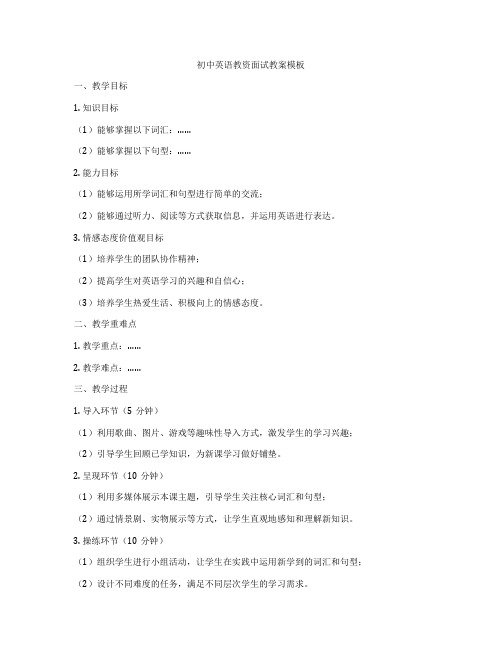
初中英语教资面试教案模板一、教学目标1. 知识目标(1)能够掌握以下词汇:……(2)能够掌握以下句型:……2. 能力目标(1)能够运用所学词汇和句型进行简单的交流;(2)能够通过听力、阅读等方式获取信息,并运用英语进行表达。
3. 情感态度价值观目标(1)培养学生的团队协作精神;(2)提高学生对英语学习的兴趣和自信心;(3)培养学生热爱生活、积极向上的情感态度。
二、教学重难点1. 教学重点:……2. 教学难点:……三、教学过程1. 导入环节(5分钟)(1)利用歌曲、图片、游戏等趣味性导入方式,激发学生的学习兴趣;(2)引导学生回顾已学知识,为新课学习做好铺垫。
2. 呈现环节(10分钟)(1)利用多媒体展示本课主题,引导学生关注核心词汇和句型;(2)通过情景剧、实物展示等方式,让学生直观地感知和理解新知识。
3. 操练环节(10分钟)(1)组织学生进行小组活动,让学生在实践中运用新学到的词汇和句型;(2)设计不同难度的任务,满足不同层次学生的学习需求。
4. 巩固环节(10分钟)(1)让学生进行听力练习,提高学生对新知识的理解和应用能力;(2)通过阅读练习,拓展学生的词汇量和阅读能力。
5. 总结环节(5分钟)(1)教师引导学生回顾本节课所学内容,加深对知识点的理解;(2)鼓励学生分享自己的学习心得,提高学生的自信心。
四、教学评估1. 课堂表现:观察学生在课堂上的参与程度、合作意识和语言表达能力;2. 作业完成情况:检查学生对课堂所学知识的掌握和应用能力;3. 测试成绩:通过听写、默写、小测验等方式,评估学生的学习效果。
五、教学反思1. 针对学生的学习情况,调整教学方法和策略;2. 关注学生的个体差异,满足不同层次学生的学习需求;3. 不断丰富教学资源,提高教学质量。
教师资格证面试复习之初中英语《试讲》各大课型教案(模板)
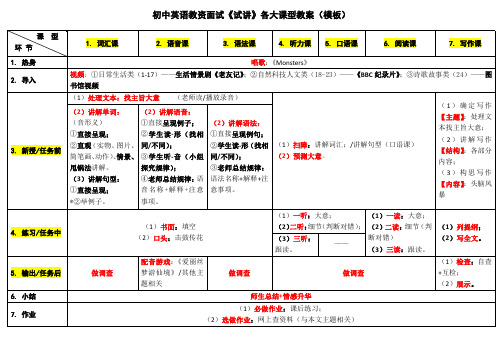
课型 环节
1. 词汇课
2. 语音课
3. 语法课
4. 听力课 5. 口语课
6. 阅读课
7. 写作课
1. 热身 2. 导入
3. 新授/任务前
唱歌:《Monsters》
视频:①日常生活类(1-17)——生活情景剧《老友记》;②自然科技人文类(18-23)——《BBC 纪录片》;③诗歌故事类(24)——图 书馆视频
5. 输出/任务后 6. 小结 7. 作业
做调查
(1)书面:填空 (2)口头:击鼓传花
(1)一听:大意;
(1)一读:大意;
(2)二听:细节(判断对错); (2)二读:细节(判
(3)三听: 跟读。
——
断对错) (3)三读:跟读。
(1)列提纲; (2)写全文。
配音游戏:《爱丽丝
(1)检查:自查
梦游仙境》/其他主
(1)处理文本:找主旨大意 (老师读/播放录音)
(2)讲解单词: (2)讲解语音:
(音形义)
①直接呈现例子;
①直接呈现;
②学生读-形(找相
②直观(实物、图片、 同/不同);
简笔画、动作)、情景、 ③学生听-音(小组
(2)讲解语法: ①直接呈现例句; ②学生读-形(找相 同/不同);
(1)扫障:讲解词汇;/讲解句型(口语课) (2)预测大意。
甩锅法讲解。
探解句型: ①直接呈现;
④老师总结规律:语 语法名称+解释+注 音 名称 +解释+注意 意事项。
*②举例子。
事项。
(1)确定写作 【主题】:处理文 本找主旨大意; (2)讲解写作 【结构】:各部分 内容; (3)构思写作 【内容】:头脑风 暴
教资面试初中英语词汇课试讲稿模板
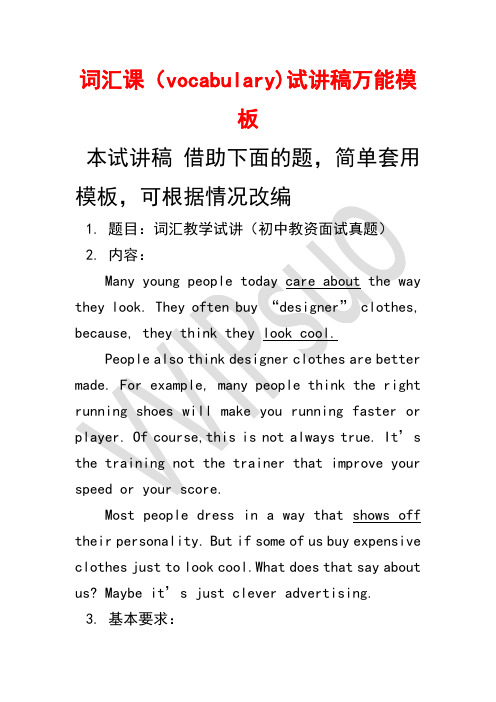
词汇课(vocabulary)试讲稿万能模
板
本试讲稿 借助下面的题,简单套用
模板,可根据情况改编
1. 题目:词汇教学试讲(初中教资面试真题) 2. 内容:
Many young people today care about the way they look. They often buy “designer” clothes, because, they think they look cool.
a seat,please. Next,the second one?
Kate,please.Very
good,take
a
seat,please.The third one, let' s guess it
together.Yes,you are all right.OK,the
meanings of them are so easy,(解释单词意思, 尽量用英文解释一两个,可板书黑板上,如果实 在想不出来,就不说,根据自身情况)but we should pay more attention to the pronunciation.Now read after me again for 3 times.(边指边读). 三、Practice:
初中英语教资教案设计之词汇
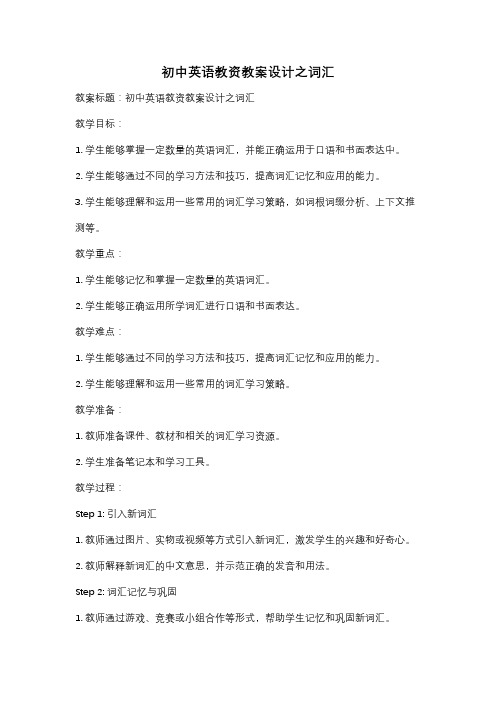
初中英语教资教案设计之词汇教案标题:初中英语教资教案设计之词汇教学目标:1. 学生能够掌握一定数量的英语词汇,并能正确运用于口语和书面表达中。
2. 学生能够通过不同的学习方法和技巧,提高词汇记忆和应用的能力。
3. 学生能够理解和运用一些常用的词汇学习策略,如词根词缀分析、上下文推测等。
教学重点:1. 学生能够记忆和掌握一定数量的英语词汇。
2. 学生能够正确运用所学词汇进行口语和书面表达。
教学难点:1. 学生能够通过不同的学习方法和技巧,提高词汇记忆和应用的能力。
2. 学生能够理解和运用一些常用的词汇学习策略。
教学准备:1. 教师准备课件、教材和相关的词汇学习资源。
2. 学生准备笔记本和学习工具。
教学过程:Step 1: 引入新词汇1. 教师通过图片、实物或视频等方式引入新词汇,激发学生的兴趣和好奇心。
2. 教师解释新词汇的中文意思,并示范正确的发音和用法。
Step 2: 词汇记忆与巩固1. 教师通过游戏、竞赛或小组合作等形式,帮助学生记忆和巩固新词汇。
2. 教师可以设计词汇卡片、填空练习或词汇拼写等活动,让学生积极参与。
Step 3: 词汇应用与拓展1. 教师设计口语练习、问答环节或小组讨论等活动,让学生运用所学词汇进行实际的交流和表达。
2. 教师引导学生通过阅读文章、写作练习或听力训练等方式,拓展和应用所学词汇。
Step 4: 词汇学习策略教授1. 教师介绍一些常用的词汇学习策略,如词根词缀分析、上下文推测、词汇网络等。
2. 教师示范和引导学生使用这些策略,提高词汇记忆和应用的能力。
Step 5: 总结与评价1. 教师与学生一起总结本节课所学的新词汇和词汇学习策略。
2. 教师可以设计课堂测验或小组展示等方式,评价学生对词汇的掌握程度。
教学拓展:1. 学生可通过课后作业、词汇学习App或在线资源等方式,继续巩固和拓展所学词汇。
2. 学生可自主学习和探索其他词汇学习策略,并与同学分享和交流。
教学反思:1. 教师根据学生的学习情况和反馈,及时调整教学策略和方法,提高教学效果。
初中英语教资复试教案模板
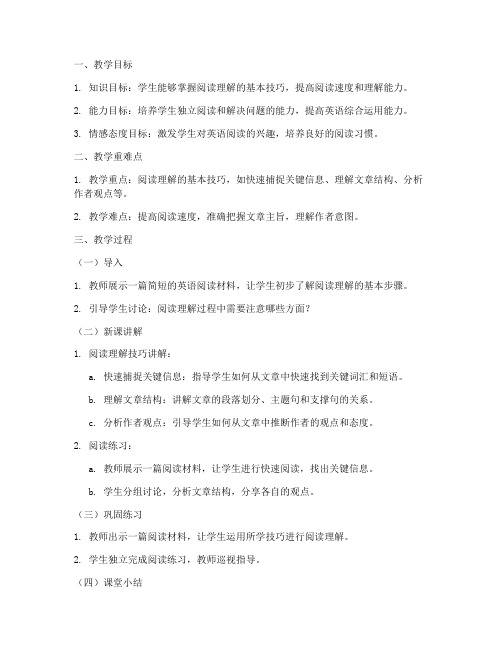
一、教学目标1. 知识目标:学生能够掌握阅读理解的基本技巧,提高阅读速度和理解能力。
2. 能力目标:培养学生独立阅读和解决问题的能力,提高英语综合运用能力。
3. 情感态度目标:激发学生对英语阅读的兴趣,培养良好的阅读习惯。
二、教学重难点1. 教学重点:阅读理解的基本技巧,如快速捕捉关键信息、理解文章结构、分析作者观点等。
2. 教学难点:提高阅读速度,准确把握文章主旨,理解作者意图。
三、教学过程(一)导入1. 教师展示一篇简短的英语阅读材料,让学生初步了解阅读理解的基本步骤。
2. 引导学生讨论:阅读理解过程中需要注意哪些方面?(二)新课讲解1. 阅读理解技巧讲解:a. 快速捕捉关键信息:指导学生如何从文章中快速找到关键词汇和短语。
b. 理解文章结构:讲解文章的段落划分、主题句和支撑句的关系。
c. 分析作者观点:引导学生如何从文章中推断作者的观点和态度。
2. 阅读练习:a. 教师展示一篇阅读材料,让学生进行快速阅读,找出关键信息。
b. 学生分组讨论,分析文章结构,分享各自的观点。
(三)巩固练习1. 教师出示一篇阅读材料,让学生运用所学技巧进行阅读理解。
2. 学生独立完成阅读练习,教师巡视指导。
(四)课堂小结1. 教师总结本节课所学内容,强调阅读理解技巧的重要性。
2. 学生分享自己的阅读心得,提出疑问。
四、作业布置1. 学生阅读一篇课外英语文章,运用所学技巧进行理解。
2. 完成课后阅读理解练习,巩固所学知识。
五、板书设计英语阅读理解1. 快速捕捉关键信息2. 理解文章结构3. 分析作者观点六、教学反思本节课通过讲解阅读理解技巧、阅读练习和课堂小结,旨在提高学生的英语阅读理解能力。
在教学过程中,应注意以下几点:1. 营造轻松、愉快的课堂氛围,激发学生的学习兴趣。
2. 注重培养学生的阅读习惯,提高阅读速度和理解能力。
3. 加强课堂互动,让学生在讨论中提高自己的英语表达能力。
4. 课后关注学生的学习情况,及时调整教学策略。
教资面试英语教案模板初中
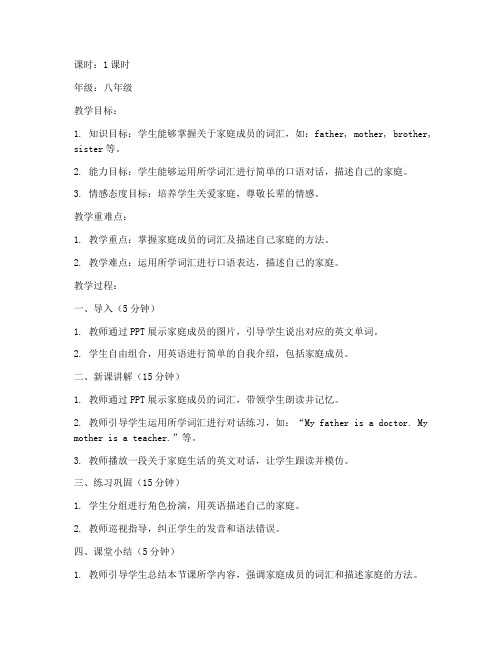
课时:1课时年级:八年级教学目标:1. 知识目标:学生能够掌握关于家庭成员的词汇,如:father, mother, brother, sister等。
2. 能力目标:学生能够运用所学词汇进行简单的口语对话,描述自己的家庭。
3. 情感态度目标:培养学生关爱家庭,尊敬长辈的情感。
教学重难点:1. 教学重点:掌握家庭成员的词汇及描述自己家庭的方法。
2. 教学难点:运用所学词汇进行口语表达,描述自己的家庭。
教学过程:一、导入(5分钟)1. 教师通过PPT展示家庭成员的图片,引导学生说出对应的英文单词。
2. 学生自由组合,用英语进行简单的自我介绍,包括家庭成员。
二、新课讲解(15分钟)1. 教师通过PPT展示家庭成员的词汇,带领学生朗读并记忆。
2. 教师引导学生运用所学词汇进行对话练习,如:“My father is a doctor. My mother is a teacher.”等。
3. 教师播放一段关于家庭生活的英文对话,让学生跟读并模仿。
三、练习巩固(15分钟)1. 学生分组进行角色扮演,用英语描述自己的家庭。
2. 教师巡视指导,纠正学生的发音和语法错误。
四、课堂小结(5分钟)1. 教师引导学生总结本节课所学内容,强调家庭成员的词汇和描述家庭的方法。
2. 学生分享自己在练习中的收获。
五、作业布置(5分钟)1. 请学生回家后,用英语描述自己的家庭,并请家长签字。
2. 请学生收集关于家庭成员的图片,制作一份手抄报。
教学评价:1. 课堂表现:观察学生在课堂上的参与度、发言情况等。
2. 作业完成情况:检查学生的家庭描述手抄报和家长的签字。
3. 口语表达:通过角色扮演和对话练习,评价学生的口语表达能力。
板书设计:一、Family Members1. father2. mother3. brother4. sister5. grandpa6. grandma二、How to describe my family1. My father is a doctor.2. My mother is a teacher.3. My brother is a student.4. My sister is a doctor.教学反思:1. 在新课讲解环节,应注重学生的发音和语法,避免学生形成错误的语感。
教招初中英语面试:《阅读理解》教案
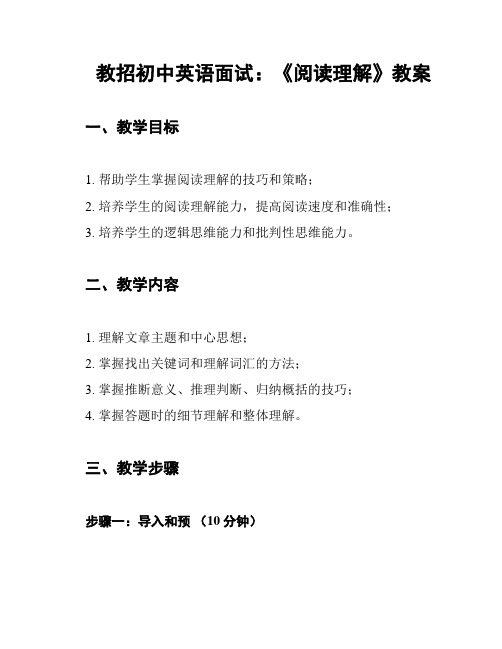
教招初中英语面试:《阅读理解》教案一、教学目标1. 帮助学生掌握阅读理解的技巧和策略;2. 培养学生的阅读理解能力,提高阅读速度和准确性;3. 培养学生的逻辑思维能力和批判性思维能力。
二、教学内容1. 理解文章主题和中心思想;2. 掌握找出关键词和理解词汇的方法;3. 掌握推断意义、推理判断、归纳概括的技巧;4. 掌握答题时的细节理解和整体理解。
三、教学步骤步骤一:导入和预(10分钟)- 教师出示一篇阅读理解文章的标题和开头段落,向学生提问引导他们查找文章主题和中心思想;- 学生根据题目和开头段落的信息,大致预测文章的内容。
步骤二:整体阅读和理解(15分钟)- 学生进行整体阅读,通过快速浏览找出文章中的关键词;- 学生用自己的话概括文章的大意和主旨。
步骤三:细节理解和推断意义(20分钟)- 学生重新阅读文章,注重细节理解,找出关键信息和细节事实;- 学生通过推断意义来解决一些可能性问题。
步骤四:推理判断和归纳概括(15分钟)- 学生阅读问题并将其与文章的信息进行对比;- 学生通过归纳概括文章的内容来解决一些综合性问题。
步骤五:解答问题和讨论(20分钟)- 学生回答问题;- 学生与其他同学讨论答案和解题思路。
步骤六:反思与总结(10分钟)- 学生总结这堂课所研究的阅读理解技巧和策略;- 学生思考如何在以后的研究中运用这些技巧和策略。
四、教学评估1. 通过课堂练,教师评估学生在阅读理解方面的掌握情况;2. 通过学生的参与程度和回答问题的准确性,评估学生的理解能力和批判性思维能力。
五、教学延伸1. 给学生分发阅读理解练题,让他们在课后继续练;2. 鼓励学生多读英语文章,提高阅读的速度和准确性;3. 提供更多的阅读材料,让学生进行自主阅读和理解。
以上为教招初中英语面试的《阅读理解》教案,希望对您有所帮助。
如有其他问题,请随时告诉我。
教资初中英语词汇教案模板
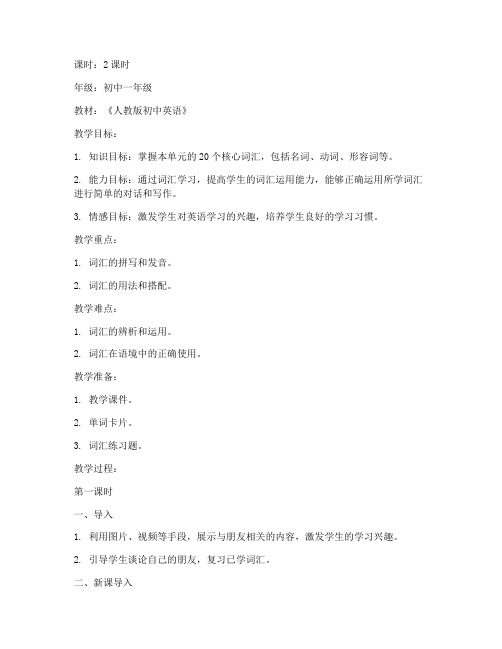
课时:2课时年级:初中一年级教材:《人教版初中英语》教学目标:1. 知识目标:掌握本单元的20个核心词汇,包括名词、动词、形容词等。
2. 能力目标:通过词汇学习,提高学生的词汇运用能力,能够正确运用所学词汇进行简单的对话和写作。
3. 情感目标:激发学生对英语学习的兴趣,培养学生良好的学习习惯。
教学重点:1. 词汇的拼写和发音。
2. 词汇的用法和搭配。
教学难点:1. 词汇的辨析和运用。
2. 词汇在语境中的正确使用。
教学准备:1. 教学课件。
2. 单词卡片。
3. 词汇练习题。
教学过程:第一课时一、导入1. 利用图片、视频等手段,展示与朋友相关的内容,激发学生的学习兴趣。
2. 引导学生谈论自己的朋友,复习已学词汇。
二、新课导入1. 教师展示单词卡片,引导学生认读。
2. 学生跟读,教师纠正发音。
三、词汇学习1. 教师讲解20个核心词汇的拼写、发音和用法。
2. 学生跟读,教师抽查。
四、练习巩固1. 学生分组,进行词汇接龙游戏,巩固所学词汇。
2. 教师提问,检查学生对词汇的理解和应用。
五、小结1. 教师总结本节课所学词汇,强调重点和难点。
2. 学生复述所学词汇,教师点评。
第二课时一、复习导入1. 回顾上节课所学词汇,引导学生复习。
2. 学生自由搭配词汇,进行对话练习。
二、词汇运用1. 教师出示情景,让学生运用所学词汇进行对话。
2. 学生分组,进行角色扮演,巩固词汇运用。
三、写作训练1. 教师给出写作主题,要求学生运用所学词汇写一篇短文。
2. 学生独立完成写作,教师巡视指导。
四、展示与评价1. 学生展示自己的写作成果,教师点评。
2. 学生互相评价,分享学习心得。
五、小结1. 教师总结本节课所学内容,强调词汇运用的重要性。
2. 学生复述所学词汇,教师点评。
教学反思:1. 本节课通过多种教学手段,激发学生的学习兴趣,提高学生的词汇运用能力。
2. 在教学过程中,关注学生的个体差异,给予学生充分的练习机会。
3. 在今后的教学中,继续探索有效的词汇教学方法,提高学生的英语素养。
- 1、下载文档前请自行甄别文档内容的完整性,平台不提供额外的编辑、内容补充、找答案等附加服务。
- 2、"仅部分预览"的文档,不可在线预览部分如存在完整性等问题,可反馈申请退款(可完整预览的文档不适用该条件!)。
- 3、如文档侵犯您的权益,请联系客服反馈,我们会尽快为您处理(人工客服工作时间:9:00-18:30)。
阅读+词汇课详案Step 1. 导入Good morning, boys and girls, how are you today! You all have a good day? I also hope that you will enjoy today’s class. Let’s get started. I have a video clip here. Let’s watch it together and tell me what is it about? //The video is over. What is it? Yes, it’s a movie called transformers. And in this movie there are many super power cars that can change into human figures, right? So these are kind of robots. But now I have a question “Do you think there will be more or fewer robots made in the future? And why?” Four students as a group to discuss this question. Five minutes for you. Ok, let’s get rolling. // Time is up! Group 1, what’s the opinion of your group?//You all think that there will be more robots in the future because they are very helpful.//Sounds reasonable! What’s the opinion of Group 3? I saw you really have a hot debate.//Your group disagrees with Group 1 because you all think robots cannot replace human.//Excellent answer. We know that it is true in some way or another.Step 2. 读前As we all know, robots have been made for a very long time. From very simple one to very complicated one. Now we have a guess, whether there will be robot for everyone in the future.//Some students said yes, and others said no. Do you want to know the answer? Now let’s read the passage to find it out.Step 3. 读中You are supposed to skim for 3 minutes and then tell me the main idea and the answer to our last question. //Finished? So what’s the main idea of this passage? Jack, ple ase. Jack said that it’s mainly about robots, such as the shape of them and the function of them. Is he right? Yes, nicely done. sit down please. And next question, whether there will be robot for everyone in the future? Milly? You said that different people hold different opinions. But who is agree and who is not? No? others? You all don’t know? Ok, that’s all right.Let’s read the passage carefully again and then we do a match about who is agreed/disagreed that there will be robots just like human. Let’s do it! Here we go! //Who could answer this question? Any volunteers? Yes, Peter. //Ok, he said “scientist James White thinks that it will be difficult for a robot to do the same things as a person.” Is he right? Yes. he has got exactly the right answer. You really read very carefully about this text. I can tell. Sit down please.Another question for you. Why fewer people will do simple jobs over and over again? Iris, please. You said that because they are boring, but robots never get bored. Is she righ t? Excellent! Then in this sentence. I find two words. “bored” and “boring”. They are very much alike. What’s the difference between them? Jack? You think they are the same? Think it again. Look at the sentence. The subject of the first sentence is jobs, right? But the subject of the second sentence is human-like robots. So can you tell the difference now? You said boring is to describe things and bored is used to describe human or human like things. Yes, exactly. Now everyone clear about the difference between them? Ok, now I have a filling the blank task on the blackboard for you. 2 minute foryou to fill in them with proper words. I see all of you have finished. who would like to come to the blackboard and finish them? Ok, Rita puts up her hand. Brave girl. Come here.//She finished. Please go back to your seat. Let’s check the answer together. The first one, right, the second one, right. And the third one? Not right? Ok, let’s help her correct it. It should be “Her mother wore a worried look.” Not worrying. Because the action is done by a person, right? ok, very good. Now, do you all clear about their difference? Ok.Now, let’s read this passage out loud together and pay attention to your pronunciation.//Your voices are all so beautiful.Step 4. 读后We have already read through this passage and get the meaning of it. Now we are going to have a debate on the topic of “Will there be robots just like human?” In the debate sentence patterns learned should be used, ok? Let’s see which side would be better. //You really had a hot debate. I can see each side has made clear their opinions and explain their reasons. You all did a very good job in this debate.Step 5. 总结Now Cindy, can you summarize what we have learned in this lesson today? Quite right, we have learnt a passage about robots and know some details about it. And we learn two very much alike words and know their difference ….You know what? All of you could in the future help promote the development of robot. And learning knowledge constantly is of great importance. Always bear in mind.Step 6. 作业Today’s homework is to collect more information about robots and write a review about this article. And next class I hope that you can share your own review in front of the class. My dear class, let’s call it a day.板书:。
